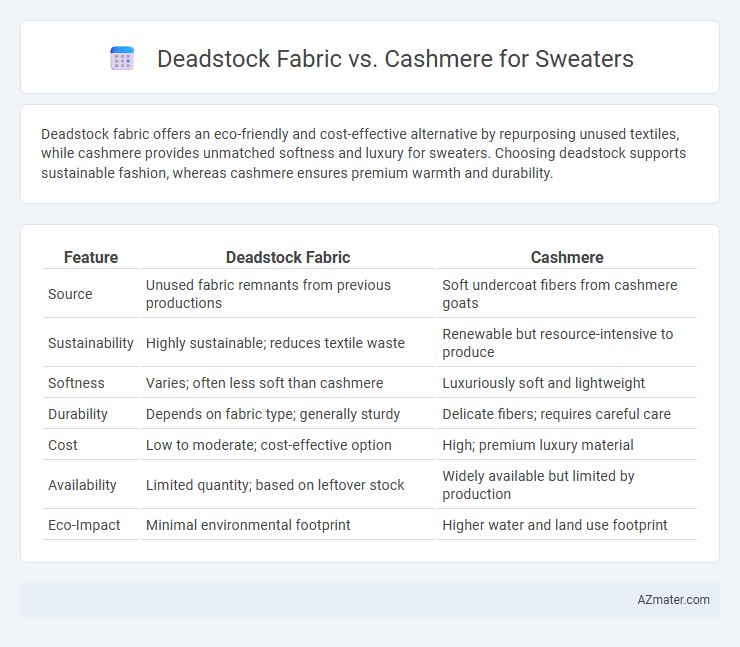Deadstock fabric offers an eco-friendly and cost-effective alternative by repurposing unused textiles, while cashmere provides unmatched softness and luxury for sweaters. Choosing deadstock supports sustainable fashion, whereas cashmere ensures premium warmth and durability.
Table of Comparison
| Feature | Deadstock Fabric | Cashmere |
|---|---|---|
| Source | Unused fabric remnants from previous productions | Soft undercoat fibers from cashmere goats |
| Sustainability | Highly sustainable; reduces textile waste | Renewable but resource-intensive to produce |
| Softness | Varies; often less soft than cashmere | Luxuriously soft and lightweight |
| Durability | Depends on fabric type; generally sturdy | Delicate fibers; requires careful care |
| Cost | Low to moderate; cost-effective option | High; premium luxury material |
| Availability | Limited quantity; based on leftover stock | Widely available but limited by production |
| Eco-Impact | Minimal environmental footprint | Higher water and land use footprint |
Introduction to Sweater Fabrics
Sweater fabrics vary widely, with deadstock fabric and cashmere standing out for their distinct qualities. Deadstock fabric consists of leftover materials from previous production runs, offering unique, sustainable options with reduced environmental impact. Cashmere, derived from the soft undercoat of cashmere goats, provides unparalleled warmth and luxury, making it a premium choice for high-quality sweaters.
What is Deadstock Fabric?
Deadstock fabric refers to unused, leftover textile material from previous manufacturing runs that remains unsold or unused, often sourced from surplus stock. This fabric is valued for its sustainability, as it reduces waste by repurposing high-quality materials that would otherwise be discarded. Unlike cashmere, which is a luxury fiber made from the soft undercoat of cashmere goats, deadstock fabric can encompass a variety of fiber types and offers an eco-friendly alternative for sweater production.
Understanding Cashmere Yarn
Cashmere yarn originates from the fine undercoat fibers of the Cashmere goat, prized for its exceptional softness, warmth, and lightweight properties, making it ideal for luxurious sweaters. Deadstock fabric consists of leftover textile materials from previous production runs, often repurposed to reduce waste but lacking the specialized qualities of pure cashmere yarn. Understanding the superior fiber structure and rarity of Cashmere yarn highlights its value over deadstock fabric in sweater quality and comfort.
Sustainability: Deadstock vs Cashmere
Deadstock fabric repurposes surplus textile waste, significantly reducing environmental impact by minimizing fabric landfill contributions and wasting fewer resources compared to cashmere, which demands extensive grazing land and water consumption for goat herding. The production of cashmere often leads to overgrazing, resulting in soil degradation and increased greenhouse gas emissions. Choosing deadstock fabric for sweaters supports circular fashion models prioritizing resource efficiency and lower carbon footprints over the high ecological costs associated with cashmere production.
Comfort & Feel Comparison
Deadstock fabric offers a unique texture with a blend of vintage softness and durability, making it a comfortable choice for sweaters that retain character over time. Cashmere, sourced from the undercoat of cashmere goats, provides unparalleled softness and lightweight warmth, creating a luxurious feel against the skin. While deadstock fabric emphasizes sustainability and distinctive texture, cashmere excels in delivering premium comfort through its fine fibers and insulating properties.
Durability and Care
Deadstock fabric offers exceptional durability due to its tightly woven construction and often natural fibers, making sweaters long-lasting with minimal wear. Cashmere, while luxuriously soft and warm, requires delicate care such as gentle hand washing or dry cleaning to maintain its quality and prevent pilling or stretching. Proper maintenance significantly extends the lifespan of cashmere sweaters, whereas deadstock fabric sweaters typically withstand regular machine washing and everyday use with greater resilience.
Price Differences
Deadstock fabric offers a cost-effective alternative to traditional cashmere sweaters, often priced significantly lower due to its surplus or unused material status. Cashmere sweaters command premium prices because of the labor-intensive production process and the rarity of cashmere fibers, driving up the cost per ounce compared to deadstock fabrics. Choosing deadstock fabric not only reduces expenditure but also supports sustainable fashion by repurposing existing textile stocks.
Style Versatility
Deadstock fabric offers unique, limited-edition patterns and textures that enhance a sweater's style versatility by enabling one-of-a-kind fashion statements. Cashmere provides a luxurious softness and timeless elegance, making sweaters suitable for both casual and formal occasions. Combining deadstock fabric's distinctiveness with cashmere's refined appeal creates sweaters that adapt seamlessly across diverse style settings.
Environmental Impact
Deadstock fabric, sourced from surplus or unused textile inventory, significantly reduces environmental waste by diverting materials from landfills and minimizing resource consumption. Cashmere production, on the other hand, often contributes to overgrazing and habitat degradation due to high demand for goat fibers, leading to soil erosion and biodiversity loss. Choosing sweaters made from deadstock fabric offers a more sustainable alternative by lowering carbon footprints and promoting circular fashion practices compared to conventional cashmere.
Which Sweater Fabric Should You Choose?
Deadstock fabric offers a sustainable option by repurposing unused textile inventory, often resulting in unique, limited-edition sweaters with eco-friendly appeal, while cashmere provides unmatched softness, warmth, and luxury. Choosing between deadstock and cashmere depends on prioritizing environmental impact and exclusivity versus premium comfort and classic elegance. Factors such as budget, intended use, and personal values toward sustainability versus traditional luxury should guide your sweater fabric selection.

Infographic: Deadstock Fabric vs Cashmere for Sweater
 azmater.com
azmater.com